Schloss Hellbrunn was built in the early 17th century, at the command of Archbishop Markus Sittikus. It was intended to be a "summer palace"--a place for the great and good of Salzburg to spend a summer afternoon, before returning to their homes in the city. The archbishop's guests would dine al fresco in the Roman Theater, surrounded by fountains and statues. The basin in the middle of the table keeps the wine chilled. And the table and seats have hidden water jets that would soak the guests (but not the archbishop). Remember, court etiquette dictates that one cannot rise from the table unless the highest-ranking person does so first. So the archbishop would stay dry and seated, while his guests had to master their surprise and discomfort...and remain seated, no matter what.
 |
| The Royal Table in the Roman Theater. |
 |
| A close up of the decoration in the Neptune Grotto. |
Upon leaving the Neptune Grotto and the charming Germaul, you have the chance to get sprayed with water...again. And, after escaping from the grotto and standing safely outside...this happens:
 | ||
| Don't look up! |
Delight, amazement, uncertainty, and suspicion mingle with one another; these emotions are punctuated by bursts of Schadenfreude when an unsuspecting person gets thoroughly soaked. (For example, during my tour, the brave souls who sat at the Royal Table spent the next hour looking like they'd wet their pants.)
Along the way are small tableaux quasi-vivants, illustrating scenes of artisanal labor and Classical myth. (Blogger won't let me upload the video, so this still shot will have to do.)
 |
| This is a scene of a couple grinding scissors. |
 | ||||
| The crown falls back down. The spectators are amazed! |
 |
| This might be the most amazing aspect of my entire visit. |
